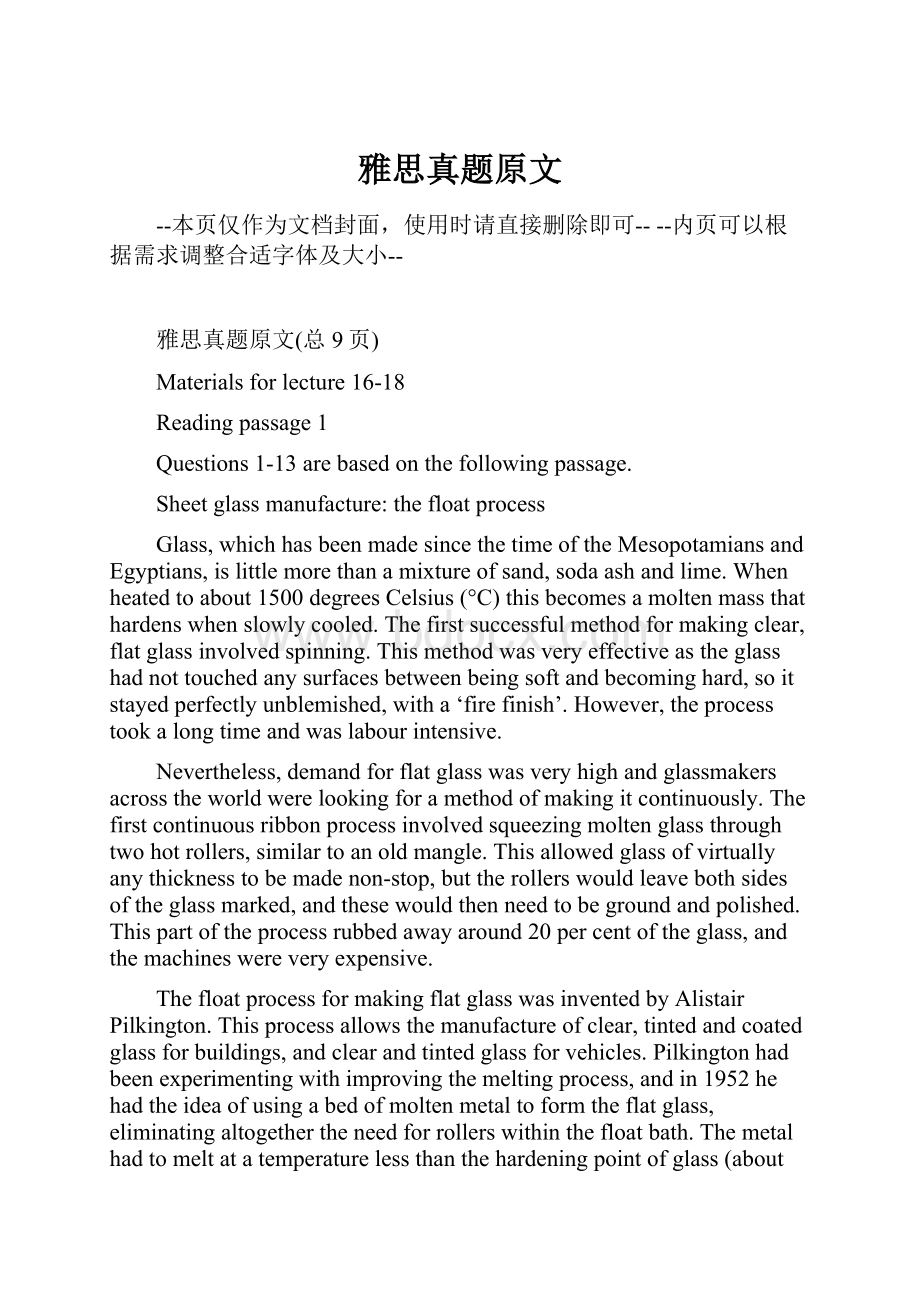 雅思真题原文Word下载.docx
雅思真题原文Word下载.docx
- 文档编号:22307604
- 上传时间:2023-02-03
- 格式:DOCX
- 页数:11
- 大小:445.10KB
雅思真题原文Word下载.docx
《雅思真题原文Word下载.docx》由会员分享,可在线阅读,更多相关《雅思真题原文Word下载.docx(11页珍藏版)》请在冰豆网上搜索。

Materialsforlecture16-18
Readingpassage1
Questions1-13arebasedonthefollowingpassage.
Sheetglassmanufacture:
thefloatprocess
Glass,whichhasbeenmadesincethetimeoftheMesopotamiansandEgyptians,islittlemorethanamixtureofsand,sodaashandlime.Whenheatedtoabout1500degreesCelsius(°
C)thisbecomesamoltenmassthathardenswhenslowlycooled.Thefirstsuccessfulmethodformakingclear,flatglassinvolvedspinning.Thismethodwasveryeffectiveastheglasshadnottouchedanysurfacesbetweenbeingsoftandbecominghard,soitstayedperfectlyunblemished,witha‘firefinish’.However,theprocesstookalongtimeandwaslabourintensive.
Nevertheless,demandforflatglasswasveryhighandglassmakersacrosstheworldwerelookingforamethodofmakingitcontinuously.Thefirstcontinuousribbonprocessinvolvedsqueezingmoltenglassthroughtwohotrollers,similartoanoldmangle.Thisallowedglassofvirtuallyanythicknesstobemadenon-stop,buttherollerswouldleavebothsidesoftheglassmarked,andthesewouldthenneedtobegroundandpolished.Thispartoftheprocessrubbedawayaround20percentoftheglass,andthemachineswereveryexpensive.
ThefloatprocessformakingflatglasswasinventedbyAlistairPilkington.Thisprocessallowsthemanufactureofclear,tintedandcoatedglassforbuildings,andclearandtintedglassforvehicles.Pilkingtonhadbeenexperimentingwithimprovingthemeltingprocess,andin1952hehadtheideaofusingabedofmoltenmetaltoformtheflatglass,eliminatingaltogethertheneedforrollerswithinthefloatbath.Themetalhadtomeltatatemperaturelessthanthehardeningpointofglass(about600°
C),butcouldnotboilatatemperaturebelowthetemperatureofthemoltenglass(about1500°
C).Thebestmetalforthejobwastin.
Therestoftheconceptreliedongravity,whichguaranteedthatthesurfaceofthemoltenmetalwasperfectlyflatandhorizontal.Consequently,whenpouringmoltenglassontothemoltentin,theundersideoftheglasswouldalsobeperfectlyflat.Iftheglasswerekepthotenough,itwouldflowoverthemoltentinuntilthetopsurfacewasalsoflat,horizontalandperfectlyparalleltothebottomsurface.Oncetheglasscooledto604°
Corlessitwastoohardtomarkandcouldbetransportedoutofthecoolingzonebyrollers.Theglasssettledtoathicknessofsixmillimetresbecauseofsurfacetensioninteractionsbetweentheglassandthetin.Byfortunatecoincidence,60percentoftheflatglassmarketatthattimewasforsix-millimetreglass.
Pilkingtonbuiltapilotplantinandby1955hehadconvincedhiscompanytobuildafull-scaleplant.However,ittook14monthsofnon-stopproduction,costingthecompany£
100,000amonth,beforetheplantproducedanyusableglass.Furthermore,oncetheysucceededinmakingmarketableflatglass,themachinewasturnedoffforaservicetoprepareitforyearsofcontinuousproduction.Whenitstartedupagainittookanotherfourmonthstogettheprocessrightagain.Theyfinallysucceededin1959andtherearenowfloatplantsallovertheworld,witheachabletoproducearound1000tonsofglasseveryday,non-stopforaround15years.
Floatplantstodaymakeglassofnearopticalquality.Severalprocesses-melting,refining,homogenising-takeplacesimultaneouslyinthe2000tonnesofmoltenglassinthefurnace.Theyoccurinseparatezonesinacomplexglassflowdrivenbyhightemperatures.Itaddsuptoacontinuousmeltingprocess,lastingaslongas50hours,thatdeliversglasssmoothlyandcontinuouslytothefloatbath,andfromtheretoacoatingzoneandfinallyaheattreatmentzone,wherestressesformedduringcoolingarerelieved.
Theprincipleoffloatglassisunchangedsincethe1950s.However,theproducthaschangeddramatically,fromasinglethicknessofmmtoarangefromsub-millimetreto25mm,fromaribbonfrequentlymarredbyinclusionsandbubblestoalmostopticalperfection.Toensurethehighestquality,inspectiontakesplaceateverystage.Occasionally,abubbleisnotremovedduringrefining,asandgrainrefusestomelt,atremorinthetinputsripplesintotheglassribbon.Automatedon-lineinspectiondoestwothings.Firstly,itrevealsprocessfaultsupstreamthatcanbecorrected.Inspectiontechnologyallowsmorethan100millionmeasurementsasecondtobemadeacrosstheribbon,locatingflawstheunaidedeyewouldbeunabletosee.Secondly,itenablescomputersdownstreamtosteercuttersaroundflaws.
Floatglassissoldbythesquaremetre,andatthefinalstagecomputerstranslatecustomerrequirementsintopatternsofcutsdesignedtominimisewaste.
Questions9-13
DothefollowingstatementsagreewiththeinformationgiveninReadingPassage1?
Inboxes9-13onyouranswersheet,write
TRUEifthestatementagreeswiththeinformation
FALSEifthestatementcontradictstheinformation
NOTGIVENifthereisnoinformationonthisinthepassage
9.Themetalusedinthefloatprocesshadtohavespecificproperties.
10.Pilkingtoninvestedsomeofhisownmoneyinhisfloatplant.
11.Pilkington’sfirstfull-scaleplantwasaninstantcommercialsuccess.
12.TheprocessinventedbyPilkingtonhasnowbeenimproved.
13.Computersarebetterthanhumansatdetectingfaultsinglass.
THELITTLEICEAGE
AThisbookwillprovideadetailedexaminationoftheLittleIceAgeandotherclimaticshifts,but,beforeIembarkonthat,letmeprovideahistoricalcontext.Wetendtothinkofclimate-asopposedtoweather-assomethingunchanging,yethumanityhasbeenatthemercyofclimatechangeforitsentireexistence,withatleasteightglacialepisodesinthepast730,000years.OurancestorsadaptedtotheuniversalbutirregularglobalwarmingsincetheendofthelastgreatIceAge,around10,000yearsago,withdazzlingopportunism.Theydevelopedstrategiesforsurvivingharshdroughtcycles,decadesofheavyrainfallorunaccustomedcold;
adoptedagricultureandstock-raising,whichrevolutionisedhumanlife;
andfoundedtheworld’sfirstpre-industrialcivilisationsinEgypt,MesopotamiaandtheAmericas.Butthepriceofsuddenclimatechange,infamine,diseaseandsuffering,wasoftenhigh.
BTheLittleIceAgelastedfromroughly1300untilthemiddleofthenineteenthcentury.Onlytwocenturiesago,Europeexperiencedacycleofbitterlycoldwinters;
mountainglaciersintheSwissAlpswerethelowestinrecordedmemory,andpackicesurroundedIcelandformuchoftheyear.TheclimaticeventsoftheLittleIceAgedidmorethanhelpshapethemodernworld.Theyarethedeeplyimportantcontextforthecurrentunprecedentedglobalwarming.TheLittleIceAgewasfarfromadeepfreeze,however;
ratheranirregularseesawofrapidclimaticshifts,fewlastingmorethanaquarter-century,drivenbycomplexandstilllittleunderstoodinteractionsbetweentheatmosphereandtheocean.Theseesawbroughtcyclesofintenselycoldwintersandeasterlywinds,thenswitchedabruptlytoyearsofheavyspringandearlysummerrains,mildwinters,andfrequentAtlanticstorms,ortoperiodsofdroughts,lightnortheasterlywinds,andsummerheatwaves.
CReconstructingtheclimatechangesofthepastisextremelydifficult,becausesystematicweatherobservationsbeganonlyafewcenturiesago,inEuropeandNorthAmerica.RecordsfromIndiaandtropicalAfricaareevenmorerecent.Forthetimebeforerecordsbegan,wehaveonly‘proxyrecords’reconstructedlargelyfromtreeringsandicecores,supplementedbyafewincompletewrittenaccounts.Wenowhavehundredsoftree-ringrecordsfromthroughoutthenorthernhemisphere,andmanyfromsouthoftheequator,too,amplifiedwithagrowingbodyoftemperaturedatafromicecoresdrilledinAntarctica,Greenland,thePeruvianAndes,andotherlocations.Weareclosetoaknowledgeofannualsummerandwintertemperaturevariationsovermuchofthenorthernhemispheregoingback600years.
DThisbookisanarrativehistoryofclimaticshiftsduringthepasttencenturies,andsomeofthewaysinwhichpeopleinEuropeadaptedtothem.PartOnedescribestheMedievalWarmPeriod,roughly900to1200.Duringthesethreecenturies,NorsevoyagersfromNorthernEuropeexplorednorthernseas,settledGreenland,andvisitedNorthAmerica.Itwasnotatimeofuniformwarmth,forthen,asalwayssincetheGreatIceAge,therewereconstantshiftsinrainfallandtemperature.MeanEuropeantemperatureswereaboutthesameastoday,perhapsslightlycooler.
EItisknownthattheLittleIceAgecoolingbeganinGreenlandandtheArcticinabout1200.AstheArcticicepackspreadsouthward,NorsevoyagestothewestwerereroutedintotheopenAtlantic,thenendedaltogether.StorminessincreasedintheNorthAtlanticandNorthSea.Colder,muchwetterweatherdescendedonEuropebetween1315and1319,whenthousandsperishedinacontinent-widefamine.By1400,theweatherhadbecomedecidedlymoreunpredictableandstormier,withsuddenshiftsandlowertemperaturesthatculminatedinthecolddecadesofthelatesixteenthcentury.Fishwereavitalcommodityingrowingtownsandcities,wherefoodsupplieswereaconstantconcern.DriedcodandherringwerealreadythestaplesoftheEuropeanfishtrade,butchangesinwatertemperaturesforcedfishingfleetstoworkfurtheroffshore.TheBasques,Dutch,andEnglishdevelopedthefirstoffshorefishingboatsadaptedtoacolderandstormierAtlantic.AgradualagriculturalrevolutioninnorthernEuropestemmedfromconcernsoverfoodsuppliesatatimeofrisingpopulations.Therevolutioninvolvedintensivecommercialfarmingandthegrow
- 配套讲稿:
如PPT文件的首页显示word图标,表示该PPT已包含配套word讲稿。双击word图标可打开word文档。
- 特殊限制:
部分文档作品中含有的国旗、国徽等图片,仅作为作品整体效果示例展示,禁止商用。设计者仅对作品中独创性部分享有著作权。
- 关 键 词:
- 雅思 原文
 冰豆网所有资源均是用户自行上传分享,仅供网友学习交流,未经上传用户书面授权,请勿作他用。
冰豆网所有资源均是用户自行上传分享,仅供网友学习交流,未经上传用户书面授权,请勿作他用。


 1212中级汽车维修工考试试题三.docx
1212中级汽车维修工考试试题三.docx
